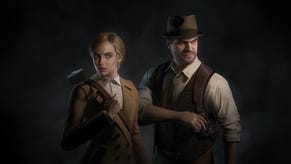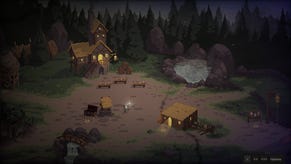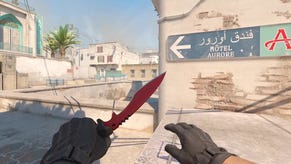The Quest Journal: Mysteries of Westgate Interview
We've written a little about the Neverwinter Nights 2 adventure pack the Mysteries of Westgate before. But not enough. We grasped the chance to talk to Ossian's Ex-Bioware head man Alan Miranda about all things to do with the Mysteries of Westgate. Candid and expansive, he expounds about the long route from Darkness over Daggerford, the DRM situation which delayed Mysteries of Westgate's release for getting on for well over a year, the problems of creating RPGs as a small team, their love for the genre and how audiences differ from country to country. And it all starts below...
RPS: Let's start with the basics and origins - could you talk about the progress from doing Darkness over Daggerford to Mysteries of Westgate? The cancelling of the premium mod program, to you pressing on with the release and then being asked to do something for NWN2... it's quite the emotional roller coaster.
Alan Miranda: The summer of 2006 was like a roller coaster for Ossian Studios, to be sure. After getting word that the NWN Premium Mod program was being cancelled, along with all its mod projects because Atari wasn’t giving approvals on them anymore, we initially felt crushed. Working for a year on a game only to have it shelved or canned happens more frequently in the industry than gamers might realize, but it never feels good on the developer’s end.
The purpose of Ossian to do the premium mod, Darkness over Daggerford (DoD), was to break into the RPG scene with a splash by releasing a really great commercial game - something the size of an expansion pack. So to have the project officially cancelled, lose all that time we’d spent working on it, and miss out on releasing anything at all as a company, really put us in a “we’re not going to take this lying down” mode. So we gritted our teeth and spent another 3 months to finish the game and gave it to fans for free. We only had a limited window to release the game before BioWare was due to release their re-instated premium mod, Wyvern’s Crown, in September (that’s a whole different story that I won’t get into). So we crunched, and crunched hard. We’d always been confident about the quality of Darkness over Daggerford, but we were truly overwhelmed by the awesome reception from fans when we released it. To date, the game has been downloaded almost 70,000 times and just keeps going.
Coming off the high (well… utter exhaustion, really) of releasing Daggerford, we were soon contacted by Atari. They hadn’t missed noticing how well DoD was doing and were very interested in having the same thing done for NWN2. At the time, we had just received the beta version of the NWN2 game/toolset, so while we experimented with that, we started pitching ideas to Atari about the game we would make for them. By January 2007 we were set to go with MoW.
Looking back at how things ended up with MoW’s release in April 2009 (over a year and a half after finishing the game), and remembering how Atari initially wanted us to keep the new content in MoW very light in order to finish and release the game before the first expansion (MotB), I am left to wonder what the game would have been like had we been able to add more content with a longer development. Some reviewers have mistakenly compared our adventure pack to an expansion pack and criticized it for not having an expansion amount of content. Budget-wise, they are a very different scale of game. Furthermore, we were contracted to deliver a 12-hour game, whereas we delivered a game that takes most players between 15 and 25 hours to play (75% of players according to a recent poll we did). Just like DoD, we went above and beyond with MoW.
RPS: What lead you and all your team to RPGs? You have your background at BioWare and, before that, Relic, but what lead you to RPGs in the first place. What about them appeals to you then? What keeps you with them now?
Alan Miranda: My background with RPGs started back in 1988, when I played D&D PnP for a few years. From tabletop, it moved to computers in early 1992 with Ultima Underworld: The Stygian Abyss, the first CRPG I had ever played (I had never heard of Ultima before then). I was so captivated by the game that I could barely study for my university exams. It laid the foundations for some of the things I love to see in RPGs, namely story, exploration, and interaction with characters and the environment. Up until that point, I’d only played computer strategy games like Strategic Conquest and the Art of War, or action games like Gauntlet. So seeing a system where you could interact with characters via dialogue was novel to me and immersive. I then played a smattering of RPGs, though quickly got into FPS and adventure games (like Monkey Island), before coming back to RPGs with Baldur’s Gate. BG had everything I was wanting in an RPG and was what eventually led me to work at BioWare. Since working professionally on RPGs, the one additional feature that I found that RPGs should have is the freedom of choice - the empowerment of the player to make meaningful decisions. RPG players always love when they have the freedom to make the choices they want in a game, so that’s something I always want Ossian RPGs to have.
As for our team, they all have their various RPG backgrounds, from playing D&D tabletop and the various D&D computer games (Gold Box games, Baldur’s Gate series, and Neverwinter Nights series) to other non-D&D ones. I think the appeal for most of them is having the space within an RPG to adequately tell a great story. Quite a few of them (such as the writers and scripters) come from a modding background where they created their own NWN1/NWN2 mods that focused on epic or tragic stories of their own creation. Also, I’m sure they were very attracted to the D&D lore that has a huge amount of depth, something that is necessary for a deep RPG experience.
RPS: RPG stories are traditionally epics. Doing an RPG story on a smaller scale than even an expansion pack has to be a challenge. Could you explain your thinking? What lead you to the city setting? Did you play with any other sorts of approaches?
You mean, how to be a mini-epic? :) Well, when your budget constrains you to be a relatively small game, trying to be epic is a challenge. I think the main criteria for us was to pick an exciting setting that was substantially rich in flavour and was unique. Then we would set the scale of the game to be an epic adventure localized in that one spot. That made choosing a city setting a good option because it’s centralized.
We chose the city of Westgate because of its melting pot of races and extreme corruption. We just had to make sure that the story taking place was compelling, and included powerful factions and characters. Westgate definitely had the latter, which is another reason we chose it (I won’t go into detail so as not to spoil the story).
The other possibility would have been for us to do a rural adventure instead of a city one. But after we found out in September 2006 that we couldn’t set the game in Rashemen because Mask of the Betrayer was set there, we had difficulty in deciding on a different rural setting that was either feasible, exciting, or hadn’t been done to death in a previous game. We were also constrained by the small amount of new art we could do, so setting the game in a place like Mulhorand (an Egyptian-style culture) was out of the question. That limited our options.
RPS: You talk about doing the game on a really tight budget. Could you talk a little about how you choose what to priortise? Development is always about these kind of choices, which I'm not sure gamers ever realise. In other words, what were your key aims for the game? How do you think you pulled them off?
Alan Miranda: Having decided to set our game in a city, we wanted to make it a place you could explore, with interesting people and places to come across. So exploration was key, but so was making Westgate feel like a city and not simply filler, with empty streets to fill in the space between Plot Point A and Plot Point B.
So we did a lot of planning on how to fill in the city with sidequests, ambient NPCs, encounters (aka fights), and interactive objects. I had seen how popular our sidequests were in Darkness over Daggerford (we don’t do the typical FedEx “Find my potato” variety) and so the gameplay for MoW was given a similar sandbox aspect to DoD, with many sidequests that you could undertake. However, MoW isn’t a complete sandbox style of game, and nor is it a strictly linear one with its core story - it’s somewhere in the middle. I think we did a good job on this aspect.
We also had the goal of improving our core story and companion NPCs from what we had done on DoD. This time around we had 4 new writers added to the team, including our lead designer, Luke Scull. They were fantastic and greatly improved what we could do in terms of story and dialogue writing. The story itself branches in several locations based on player choice, which made more work for us but we felt was important for empowering the player. I know we were successful with this because most fans have praised us for giving them those plot choices.
I honestly would have loved to do more art for MoW, but that wasn’t feasible. Since area creation depends on new art to be finalized, and design implementation (like the critical path or sidequests) depends on areas to be finalized, there wasn’t time to have a longer art development. As it was, we hadn’t initially planned to make a sewer tileset for the game, but ended up coming to the critical realization early on in development that we couldn’t do a city without one. So that became a big feat in itself to build 100 new sewer tiles. The new tileset actually delayed our development somewhat because I kept asking our 3D artist, Brian Dunn, to add in more tile variations in order to achieve the level designs that we needed to do.
Because both reviewers and fans alike have commented on the limited amount of VO in MoW, I’m going to explain that aspect. We knew from the start that there would be no way to professionally VO MoW to the extent that NWN2 had been done - there simply wasn’t the budget. Of course, having no VO was not an option either. So we approached it similar to what had been done for the NWN1 premium modules, which was recording a limited amount of VO for important characters or scenes. But I think where we went wrong was when we created cutscenes that had no VO, because those stuck out more for players as being like silent movies. We knew the problem at the time, but were caught between not being able to afford more VO or cutting out certain important cutscenes. So we left things as they were, hoping that players would understand. Some people had no problem, some identified the issue but accepted it, and others felt they had a bone to pick with it. Since the trend over the last decade has been to fully VO RPGs (vs the old BG days where just the first line in a dialogue might be recorded), it’s not a surprise that simple plain text stuck out.
RPS: While I understand this is a prickly topic, could you talk a little about the whole DRM situation? The game was held up since 2007 due to the development of DRM by Atari, and then caused a degree of uproar with the install limit - which has since been withdrawn. Could you talk a little about your feelings around this? Looking back, what do you remember? I mean, this is stating the obvious, but it has to be enormously frustrating?
Alan Miranda: It had always been the intent for the NWN2 Adventure Packs to emulate a similar kind of system to the one BioWare used for the NWN1 Premium Modules. This was obvious to me from the get-go back when we started talking to Atari seriously about a NWN2 game in the fall of 2006. The fact that it wasn’t ready by the time we finished MoW in September 2007 was frustrating.
After that point, it’s hard for me to get into details as to what the exact delays were. However, the process involved writing new encryption and authentication code, integrating it into the NWN2 code, and then retesting the MoW DRM version. This needed cooperation between Atari and Obsidian to get the implementation all pulled together, which unfortunately took longer than anyone foresaw (19 months).
During those 19 months, the whole team felt on a roller coaster as we would periodically go from “It’s almost ready to ship!” and having a MoW press event in LA in May 2008, to “No, it looks like it can’t be finished for another while.” I know that bipolar situation drove some people on the Ossian team totally nuts at times, and slowly sapped everyone’s enthusiasm. It didn’t help that we had to keep testing, retesting, and retesting MoW with every new patch that came out. But in typical Ossian fashion, we pressed on.
The 3-activation limit turned out to be very upsetting for many fans, which wasn’t a good thing for Ossian to see. We were supposed to be elated when MoW finally released. Instead, it felt tainted that half of NWN2’s fanbase refused to buy MoW on principle because of its DRM limit. It was an issue that we very much sympathized with and I started talking to Atari about it shortly after release: seeking a removal of the activation limit. It took a while, but eventually Atari agreed (this came not long after the process was underway for selling Atari Europe off to Namco-Bandai). The activation limit was removed on June 15, allowing NWN2 players to reinstall MoW as many times as they wanted. Ossian has tried to spread the word as best we can about this, but we are left to wonder how many potential buyers we’ve lost from players initially passing up MoW because of the activation limit and then not looking back.
RPS: Looking at your site, I noticed there's a string of really good reviews of the pack from Poland. Do you see marks varying much between countries? Are you aware of your games getting a better reception or more avid fanbase in different parts of the world? Would you agree that Internet discourse tends to give us the impression of gaming as a monoculture, with a disproportionate amount of attention on US activity?
Alan Miranda: You know, international score trends are something we’ve noticed but have yet to explain. It seems that Eastern Europe (such as Poland, Finland, Romania, Croatia, Hungary, and Russia) really likes MoW. One explanation is that the reviewers that gave us high scores from those countries are hardcore Neverwinter and D&D fans, which is substantiated by that fact that we also got scored highly by the top Neverwinter community sites who know Neverwinter inside-out. And from what we can tell, the majority of fans enjoyed MoW and consider it on par or better than the other official NWN2 releases. Where those fans come from in the world doesn’t seem to factor in as much as their appreciation for the Neverwinter series and what makes a good D&D RPG.
Another explanation about the higher reviews in Eastern Europe is that the writing and humour in MoW appeals to the tastes in that part of the world to a greater degree. Salty Jack, for instance, is an ambient vagrant NPC that wanders the docks in Westgate, and was singled out by some Eastern European reviewers as being a brilliant comedic character. Still, it’s hard to conclude for sure about worldwide tastes because we’ve read comments from American fans ranging from “Salty Jack is awesome” to “I can’t stand the guy.”
Something to keep in mind is that the Polish version of MoW was localized into Polish by CD Projekt (there’s a Russian version as well), so Polish players were able to read and hear everything in Polish. Other than those 2 localized versions, there was only the English version available, which is a limiting factor on the size of your international audience.
As far as having a gaming monoculture and a disproportionate amount of US coverage, that may or may not be true. Here are some thoughts about that. The location of money determines where games are made. Money dictates what are the biggest games worked on. Media likes to cover the big games most. People often believe what the media tells them is true: what are the best games and who are the best developers. The economics of self-fulfilling prophecies/crises/equilibria are a well-studied phenomenon, so maybe that applies here. If the word on the street is that Game X is the best game ever, then maybe it will become it. :)
RPS: Now the game's out, how does the team feel about the response to Westgate? What are you proud of? What are your regrets?
Alan Miranda: Ossian and the MoW team are immensely proud of Mysteries of Westgate. We set out to create a high-quality, medium-sized adventure in the traditional BioWare-RPG style for Neverwinter games, and we feel that we succeeded in that. The majority of the reviews for MoW have been positive, and what pleases us the most is that the Neverwinter fans are happy with the game.
The experience in developing MoW was quite different from DoD. Whereas DoD was the Wild West of game development with designing on the fly, MoW’s design was planned out very tightly to begin with, and them implemented in an orderly fashion. I am very proud of our team for being able to do that as a virtual company because it’s solid proof that AAA games can be developed virtually. Ossian has made that system work very well.
Our main regret obviously stems from being released 19 months late, because timing can mean everything to a game. MoW was supposed to have been released before the first NWN2 expansion pack but ended up being released 5 months after the second expansion! Its purpose was to be a sizeable appetizer on a menu of larger following courses. Its ultimate place seemingly became the cheese and crackers after the main meal was over.
It’s sad to think that MoW didn’t perform as well as it could have, not from any failure on the part of the game but because of its huge delay and initially restrictive DRM activation. In May 2008, PC Gamer’s veteran RPG reviewer, Desslock, said Mysteries of Westgate was “a real gem” and “top-notch.” Yet a year later, GameSpot gave it a 65%. That’s a pretty large difference. From the sound of it, it looked like there was the mistaken expectation from some reviewers that MoW was another expansion but failed to have all the content expected in an expansion, like new classes, lots of new art, and a large VO budget. Or even that it failed to leverage the features from previous expansions (which is impossible since MoW was finished before those games even released). That would never have been an issue had we released earlier. Perhaps having to hype the game for a year and a half (because we never knew when it would release), also led to expectations that MoW was bigger than it was. It is interesting to note that out of the 8 reviews for MoW on Metacritic (where it received a 73% average), the top 4 reviews are European and the bottom 4 are American. Extract whatever conclusion you like from that.
With Mysteries of Westgate finally released, I can say that Ossian Studios, which has expanded in size from the MoW days, is easily capable of creating a much larger RPG that succeeds on the aspects we weren’t able to maximize with MoW (yes, the cliché bigger, better, more). I am very much looking forward to the future of D&D games.
RPS: Thanks for your time.
Mysteries of Westgate is available to purchase via Direct Download either in the US or in Europe.























